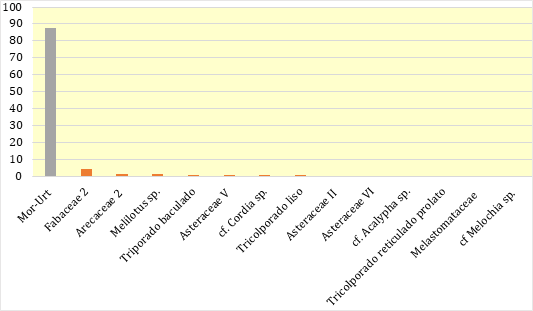Chromatic dominance of corbicular pollen load and honey collected by Apis mellifera L. in Bajo Mayo, San Martin
DOI:
https://doi.org/10.51252/raa.v3i1.432Keywords:
chromaticity, monofloral, multifloral, organolepticAbstract
The research sought to determine the chromatic dominance of the corbicular pollen load and honey collected by Apis mellifera L., from the organoleptic and physical-chemical analysis. Honey and pollen samples were taken following the Good Beekeeping Practices. The acetolysis technique was carried out for the observations, measurements and identification at the family level of the pollen grains; the measurement was made with the help of optical microscopy at 1000x. Corbicular pollen samples were separated according to color characteristics in order to confirm that each group corresponds to the same taxon. Two groups of honeys were differentiated according to their geographical and botanical origin: from Zapatero, bifloral honey, 14 pollen types were recorded, with a predominance of Urticaceae and Moraceae taxa (87.83%) and from Banda de Shilcayo, multifloral honey, 14 pollen types were recorded, where Solanaceae stand out with 40.42% and Arecaceae with 10.33%. The honey from Banda de Shilcayo attributes an amber coloration, whose brown hue contains higher acidity (pH=3.375) and electrical conductivity (EC=0.673 µS/cm); Zapatero's honey is classified as having a white coloration, since it has a slightly light tone it contains less acidity (pH=4.276) and electrical conductivity (EC=0.582 µS/cm).
Downloads
References
Almeida-Muradian, L. B., Pamplona, L. C., Coimbra, S., & Barth, O. M. (2005). Chemical composition and botanical evaluation of dried bee pollen pellets. Journal of Food Composition and Analysis, 18(1), 105–111. https://doi.org/10.1016/j.jfca.2003.10.008
Bogdanov, S. (2004). Estándar y calidad del polen y cera de abejas. Api Acta, 38, 334–341.
Codex Alimentarius. (1981). Codex Norma para la miel. (Codex Stan 12-1981). Norma adoptada en 1981. Revisiones en 1987 y 2001.
Codex Alimentarius. (2008). Codex Norma para la miel. (Codex Stan 12-1981).
Coronado-Jorge, M., Ormeño-Luna, J., Barrera-Lozano, M., & Castillo-Díaz, T. (2019). Caracteres fisicoquímicos en mieles del ecosistema del Bajo Mayo, región San Martín, Perú. Arnaldoa, 26(2), 607–622. https://dx.doi.org/10.22497/arnaldoa.262.26206
Coronado-Jorge, M., Silva-Cruz, A., Ormeño-Luna, J., Terleira-García, E., Martinez-Mena, E., & Vidaurre-Rojas, P. (2022). Caracterización físico-química de miel de abeja (Apis mellifera L.) procedentes de la Amazonía peruana. Revista Brasileira de Ciências Agrárias, 17(4), 1–7. http://www.agraria.pro.br/ojs32/index.php/RBCA/article/view/v17i4a2585
Funari, S., Rocha, H. C., Sforcin, J. M., Grassi Filho, H., Curi, P. R., Dierckx, S. M. G., Funari, A. R. M., & de Oliveira Orsi, R. (2005). Bromatological and Mineral Compositions of Collected Pollen for Africanized Honeybees (Apis Mellifera L.) in Botucatu, São Paulo State. Latin American Archives of Animal Production, 11(2), 87–93. https://ojs.alpa.uy/index.php/ojs_files/article/view/38
Guo, J., Zhang, P., & Zhang, Z. (2009). Estudios sobre componentes químicos del polen de colza recolectado por las abejas. Zhongguo Zhong Yao Za Zhi, 34(10), 1235–1237.
Hammer, O., Harper, D., & Ryan, P. (2001). Past: Paquete de software de estadísticas paleontológicas para educación y análisis de datos. Palaeontologia Electronica, 4(1), 9. http://palaeo-electronica.org/2001_1/past/issue1_01.htm
Holdridge, L. (1978). Ecología basada en zonas de vida (1st ed.). Instituto Interamericano de Ciencias Agrícolas (IICA). http://repositorio.iica.int/handle/11324/7936
Louveaux, J. (1959). Recherces sur la recolte du polen par les abeilles (Apis Mellifica L.) (fin) (1st ed.). Recherces sur la recolte du polen par les abeilles (Apis Mellifica L.) (fin).
Mercado, W., & Rimac, D. (2019). Comercialización de miel de abeja del bosque seco, distrito de Motupe, Lambayeque, Perú. Natura@economía, 4(1), 24–37. https://doi.org/10.21704/ne.v4i1.1358
Nascimento, S. G. da S., Ávila, M. R. de, Hanke, D., Haberman, M. A., Becker, C., & Aguiar, N. (2021). Adversidades y desafíos de la producción de miel en el sur de Brasil. Revista DELOS, 14(39), 17–28.
Ormeño-Luna, J., Castillo-Diaz, T., Garay-Montes, R., & Vallejos-Torres, G. (2021). Calidad de miel por “abejas nativas” (Meliponini) en la Región San Martín, Perú. Arnaldoa, 28(1), 139–148. http://journal.upao.edu.pe/Arnaldoa/article/view/1585
Silva, T. M. S., Camara, C. A., Lins, A. C. S., Agra, M. de F., Silva, E. M. S., Reis, I. T., & Freitas, B. M. (2009). Chemical composition, botanical evaluation and screening of radical scavenging activity of collected pollen by the stingless bees Melipona rufiventris (Uruçu-amarela). Anais Da Academia Brasileira de Ciências, 81(2), 173–178. https://doi.org/10.1590/S0001-37652009000200003

Published
How to Cite
Issue
Section
License
Copyright (c) 2023 Javier Ormeño-Luna, Wilson Ernesto Santander-Ruiz

This work is licensed under a Creative Commons Attribution 4.0 International License.
The authors retain their rights:
a. The authors retain their trademark and patent rights, as well as any process or procedure described in the article.
b. The authors retain the right to share, copy, distribute, execute and publicly communicate the article published in the Revista Agrotecnológica Amazónica (RAA) (for example, place it in an institutional repository or publish it in a book), with an acknowledgment of its initial publication in the RAA.
c. Authors retain the right to make a subsequent publication of their work, to use the article or any part of it (for example: a compilation of their works, notes for conferences, thesis, or for a book), provided that they indicate the source of publication (authors of the work, journal, volume, number and date).





